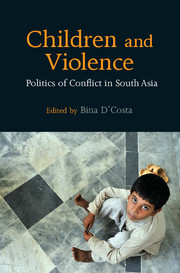Book contents
- Frontmatter
- Dedication
- Contents
- List of Map, Figures and Tables
- Acknowledgements
- Introduction: ‘Turtles Can Fly’: Vicarious Terror and the Child in South Asia
- Part I Shaping Childhood in South Asia
- Part II Conflict and Violent Peace
- Part III Rights, Needs and Protection
- 8 Children Affected by Political Violence in India: Human Rights, Politics and Protection
- 9 Rethinking Rights and Needs: The Everyday Life of Refugee Children in the Borderland
- 10 Pinning Down a Paper Tiger: Some Practice Observations on the Monitoring and Reporting Mechanism in Nepal and Asian Contexts
- Part IV Reflections from Human Rights Advocates in the Region
- Bibliography
- Notes on Contributors
- Index
9 - Rethinking Rights and Needs: The Everyday Life of Refugee Children in the Borderland
from Part III - Rights, Needs and Protection
Published online by Cambridge University Press: 05 June 2016
- Frontmatter
- Dedication
- Contents
- List of Map, Figures and Tables
- Acknowledgements
- Introduction: ‘Turtles Can Fly’: Vicarious Terror and the Child in South Asia
- Part I Shaping Childhood in South Asia
- Part II Conflict and Violent Peace
- Part III Rights, Needs and Protection
- 8 Children Affected by Political Violence in India: Human Rights, Politics and Protection
- 9 Rethinking Rights and Needs: The Everyday Life of Refugee Children in the Borderland
- 10 Pinning Down a Paper Tiger: Some Practice Observations on the Monitoring and Reporting Mechanism in Nepal and Asian Contexts
- Part IV Reflections from Human Rights Advocates in the Region
- Bibliography
- Notes on Contributors
- Index
Summary
Refugee children arguably suffer the most in refugee life, first being refugees and second being children. Many studies have highlighted various dimensions of their sufferings. Some – such as writings on war-affected children in Rwanda and the former Yugoslavia in the mid-1990s – have focused on the emotional and psychological aspects in which children are traumatized and their futures impacted by being in a hostile environment. Others have focused more on the social and legal phenomenon affecting the children's social development and protection. Such researches are mainly policy-oriented and designed to inform service providers, e.g., child-focused agencies. However, little work has been done that signifies the value of children's experiences in a conflict situation and within the refugee environment. Yoram Bilu's work on the thoughts and dreams of children affected by the Arab-Israeli conflict in the West Bank and Israel showed how the children envisioned their past, present, and future within the given environment.1 Nonetheless, viewing the whole experience of refugee life through the eyes of children is an understudied area, perhaps because: (1) refugees worldwide have been marginalized; and (2) the experiences of refugee children are regarded as even less significant. The rational of this chapter is that by looking at the refugee's experience of camp life through the children's eyes and drawings would provide a different discourse that would help to fill in the gaps in the system, and would give people a different way of looking at the problem.
In 2014, the UNHCR estimated the number of refugees worldwide to be about 51.2 million, about half of whom are children; four in five refugee children live in developing countries. Despite their untold sufferings –forced to flee their home country and losing their familiar socioeconomic, natural and political environments – and having to face and negotiate various enormous humanitarian challenges in their host countries, refugees worldwide are largely marginalized. The refugee camps are in restricted areas known as ‘exceptional places’, often not within the jurisdiction of the local laws that apply to local citizens; instead, the host government and agencies impose and implement a host of special rules, regulations, and restrictions on the individuals living in those encampments.
- Type
- Chapter
- Information
- Children and ViolencePolitics of Conflict in South Asia, pp. 220 - 242Publisher: Cambridge University PressPrint publication year: 2016



